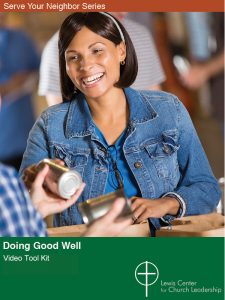Many congregations actively engage in community outreach activities that provide essential resources to those in need within our communities. While outreach is crucial, we must also strive to engage with people, fostering genuine relationships and shared efforts in our ministries. Doug Powe, of the Lewis Center staff, offers invitation and involvement as two ways congregations can move from community outreach to engagement.
Many congregations do some form of outreach to the community. It may be as simple as a food basket at Thanksgiving or something more elaborate like a weekly feeding ministry. These outreach ministries are essential and provide greatly needed resources for individuals in the community. Sometimes we confuse this “outreach” with what I call “community engagement.” For me, outreach is doing something for people and engagement is doing something with people.
Consider the example of two people canoeing. If I am the only one paddling, we may make it to our destination, but you are a passive passenger. If we paddle together toward the destination, you become an active participant rather than just a passenger. Community engagement involves community members as active participants in our ministry. Here are two ideas to help move from outreach to engagement.
Invitation
Many of our community ministries originate from ideas that arise within the congregation. For instance, we hear that there is a real need for school supplies at the local elementary so we decide we will donate 50 backpacks full of supplies. This approach does not require any input from anyone outside of the congregation, and in many cases only involves a few people within the congregation. Again, this sort of outreach is critically important and necessary in all communities. But how do we move beyond just doing outreach?
One way is to invite ministry participants to help us move an idea to reality. In the example of providing school supplies to the local elementary school, we could contact the principal and share our idea and ask to talk with teachers about what supplies are needed. This simple act helps build a relationship with the principal and some of the teachers. Another possibility is to share the idea through social media (something like Nextdoor) outlining the plan for helping the elementary school and asking community members to join in purchasing and delivering backpacks and supplies. This forges a connection with mission-minded community members whom we may not know.
The key is finding ways to invite those outside of the congregation to participate in the ministry. This moves the ministry from outreach to engagement. It broadens the participation and establishes connections with individuals who may not have been on their radar screen.
Involvement
Congregations also fall into the trap of treating ministry participants like clients receiving a service. This often happens in feeding ministries where individuals may come for a hot meal once a week and congregational volunteers set-up, cook, serve, and cleanup. Those coming eat, and may exchange a few pleasantries with the congregational volunteers, but it does not extend much beyond this level of engagement. Some congregations fear making food contingent on participation in church activities. But, I believe it is possible to deepen engagement while avoiding this fear.
Moving toward a deeper engagement means learning the names and stories of those who come weekly—not simply giving them food, but taking the time to really know them. Many people won’t share their life story in one visit, but if week after week people take the time to sit and really listen, they will reveal their stories. Being in a place of need is uncomfortable. Knowing that someone really cares beyond just providing a weekly meal can go a long way.
The next step is a big one and must be handled with care. It is inviting those who come to be a part of the ministry to partner in helping to make a difference in the community through the ministry. It may be that a person is only comfortable with set-up, serving, etc., and not with the more formal church activities like prayer before the ministry starts. Letting individuals know that they are welcome to participate at any level is important. Some will participate in the more formal activities as they belong, but it should never be forced.
Community outreach is essential and most congregations are doing something. If we really want to transform lives we need to move from outreach to engagement by inviting and helping people to be more involved.
 Related Resources
Related Resources
- Doing Good Well, a Lewis Center video tool kit resource
- 9 Strategies for Meeting New People and Learning Their Needs by Elizabeth Mae Magill
- 10 Tips for Building Genuine Connections with Your Neighbors by Kay Katan
- 4 Shifts for More Authentic Community Engagement by Dan Pizet






